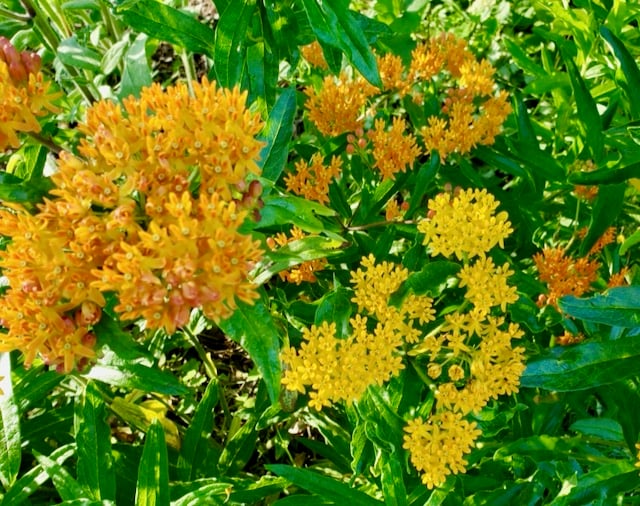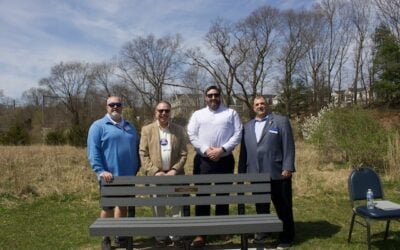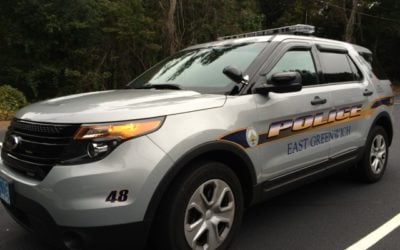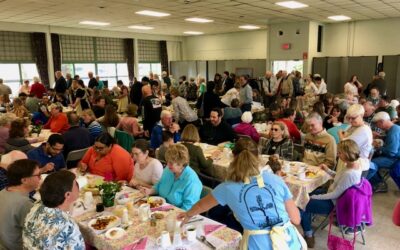Above: Yellow-flowering cultivars of butterfly weed are an example of straight-species cultivars that make no difference to monarchs and pollinators. Photo by George Christie
By George D. Christie
A monthly column
Having worked in retail garden center sales for 12 years, I am keenly aware that few things excite the garden center shopper less than plant labels. Which always surprised me because I found them to be my best friend, certainly when I was new, but truly throughout my years. When I first started in the garden center, I knew a fair amount about plants in a general sense, but I wasn’t at all sure how tall a Blue Maid holly grew, or how much sun a Gold Mound spirea could take. So, whenever a customer would ask such a question, I would say something like, “Well, this isn’t a species I’m particularly familiar with [pretending my lack of familiarity was species specific!)], so let’s check the label.” Even after 12 years, though, there were so many new cultivars and varieties, I found checking the label remained an important part of plant sales.
 Today, however, I am going to take you step-by-step through another bit of information that will help you navigate your way to those locally native plants best suited for our 21st century gardens, the scientific name. The scientific name (typically italicized) of a plant consists of a genus name, capitalized, and a species name, not capitalized, known as the scientific binomial. Our beautiful Rhode Island native Blue False Indigo is called Baptisia australis. The native milkweed that smells so sweet and attracts what Monarch butterflies remain is scientifically known as Asclepias syriaca. Note how simple these names are, two words and nothing else. This is your sweet spot, for these plants, if properly labeled, were either grown from seed or propagated vegetatively from plants grown from seed. These are the plants the Rhode Island birds and bees and butterflies will recognize and use to restitch, in part, the fabric of life that can be our future Rhode Island.
Today, however, I am going to take you step-by-step through another bit of information that will help you navigate your way to those locally native plants best suited for our 21st century gardens, the scientific name. The scientific name (typically italicized) of a plant consists of a genus name, capitalized, and a species name, not capitalized, known as the scientific binomial. Our beautiful Rhode Island native Blue False Indigo is called Baptisia australis. The native milkweed that smells so sweet and attracts what Monarch butterflies remain is scientifically known as Asclepias syriaca. Note how simple these names are, two words and nothing else. This is your sweet spot, for these plants, if properly labeled, were either grown from seed or propagated vegetatively from plants grown from seed. These are the plants the Rhode Island birds and bees and butterflies will recognize and use to restitch, in part, the fabric of life that can be our future Rhode Island.
Sadly, in a typical garden center, such plants are hard to find. With luck you’ll see something like Coreopsis verticillata ‘Moonbeam.’ The name enclosed in italics indicates this is a cultivar, or cultivated variety of the species, in this case our regionally native tickseed. When the cultivar name is attached to the scientific binomial, as it is here, it means this plant is still a straight species plant but differs in one or more key characteristics. In this case, ‘Moonbeam’ has a slightly paler flower than the straight species. But cultivars are clones and clones are genetically identical. In your suburban garden, this doesn’t make much difference, but they’d be a terrible addition to a biodiversity restoration project.
 It gets worse. Much of the time you’ll see something like Heuchera x ‘Smoke and Mirrors’. Now you’re in trouble. That frosty foliage is enticing, but the scientific name warns you to stay away. Why? Because that “x ‘Smoke and Mirrors’” indicates a hybrid plant not found in nature and, if it isn’t found in nature, species that are found in nature won’t know what to do with it.
It gets worse. Much of the time you’ll see something like Heuchera x ‘Smoke and Mirrors’. Now you’re in trouble. That frosty foliage is enticing, but the scientific name warns you to stay away. Why? Because that “x ‘Smoke and Mirrors’” indicates a hybrid plant not found in nature and, if it isn’t found in nature, species that are found in nature won’t know what to do with it.
There are also sneaky names. The lovely Heucherellas, which are hybrid between two genera, Heuchera and Tiarella, so they are completely foreign to the natural world. Again, attractive plants that have no place in a Rhode Island or regionally native garden. The silver lining of avoiding these plants, in my personal experience, is that many of these hybrids aren’t particularly strong and don’t do well in the garden. If replacing under-performing plants every two-to-three years is your idea of fun, well, snap them up. This is one lesson, however, I don’t intend to forget.
If it all sounds too complex for words, don’t despair. Just remember three things. First, look for regionally native plants identified only by their scientific binomial, Symphyotrichum novae-angliae (New England Aster), for example. Second, when in doubt, look up the specific name on your phone – you can almost always quickly discover whether or not a plant is a real local open-pollinated native or some strange, patented clone. And third, it’s okay to have a few non-native plants in your garden. Those late-blooming sedums? Not native to Rhode Island. But they have their place in our garden because both my wife and the bees love them.
Formally trained in entomology and landscape architecture, George Christie has worked in mosquito control, environmental education and garden design and plant sales. He currently works for the Rhode Island Natural History Survey managing their rare species database.






 Subscribe
Subscribe
Thank you for writing this. We all need to do our part and put more native plants in our garden. The cold in February pretty much killed everyone’s butterfly bushes and many other non native plants. Definitely taught me a lesson!
Of anyone is interested in planting milkweed for the butterflies there are many sites that will mail you seeds at no cost, just enclose postage in your letter!
I hope local nurseries carry more natives every year as I truly feel more people are getting interested in it!
Heather–You make very good points. Local nurseries do respond to customer concerns but are often overwhelmed by the marketing juggernaut of patented-brand companies like Proven Winners. The only way to compete is to speak up. Ask for native plants and explain what you are looking for. And, as always, never be rude or abrupt with staff–they aren’t the ones who make the purchasing decisions.
As a result of George’s past articles (beginning last summer) I am more aware of what plants I should buy. Beware those planting free milkweed seeds. They are terribly invasive, some sprouting at edge of planting area with roots under driveway. Even planting in a container may result in seeds sprouting elsewhere, just my two cents.